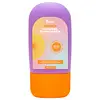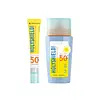What's inside
What's inside
 Key Ingredients
Key Ingredients

 Benefits
Benefits

 Concerns
Concerns

 Ingredients Side-by-side
Ingredients Side-by-side

Water
Skin ConditioningDicaprylyl Carbonate
EmollientNylon 6/12
AbsorbentOctocrylene
UV AbsorberPhenylbenzimidazole Sulfonic Acid
UV AbsorberDiethylamino Hydroxybenzoyl Hexyl Benzoate
UV FilterZinc Oxide
Cosmetic ColorantCetearyl Alcohol
EmollientGlyceryl Stearate
EmollientBis-Ethylhexyloxyphenol Methoxyphenyl Triazine
Skin ConditioningAcrylates/C12-22 Alkyl Methacrylate Copolymer
Aminomethyl Propanol
BufferingAluminum Starch Octenylsuccinate
AbsorbentC15-19 Alkane
SolventHydroxyethyl Acrylate/Sodium Acryloyldimethyl Taurate Copolymer
Emulsion StabilisingGlycerin
HumectantRubus Idaeus Leaf Extract
Skin ConditioningRibes Nigrum Leaf Extract
PerfumingTocopheryl Acetate
AntioxidantCeteth-10 Phosphate
CleansingDicetyl Phosphate
EmulsifyingHydroxyacetophenone
AntioxidantCanola Oil
EmollientArgania Spinosa Kernel Oil
EmollientArginine
MaskingCoco-Glucoside
CleansingDisodium EDTA
Ectoin
Skin ConditioningEthylhexylglycerin
Skin ConditioningDisodium Lauryl Sulfosuccinate
CleansingSodium Dilauramidoglutamide Lysine
HumectantDaucus Carota Sativa Seed Oil
EmollientBisabolol
MaskingMagnesium Chloride
Beta-Carotene
Skin ConditioningDaucus Carota Sativa Root Extract
Skin ConditioningHelianthus Annuus Seed Oil
EmollientSorbic Acid
PreservativePhenoxyethanol
PreservativeBHT
AntioxidantWater, Dicaprylyl Carbonate, Nylon 6/12, Octocrylene, Phenylbenzimidazole Sulfonic Acid, Diethylamino Hydroxybenzoyl Hexyl Benzoate, Zinc Oxide, Cetearyl Alcohol, Glyceryl Stearate, Bis-Ethylhexyloxyphenol Methoxyphenyl Triazine, Acrylates/C12-22 Alkyl Methacrylate Copolymer, Aminomethyl Propanol, Aluminum Starch Octenylsuccinate, C15-19 Alkane, Hydroxyethyl Acrylate/Sodium Acryloyldimethyl Taurate Copolymer, Glycerin, Rubus Idaeus Leaf Extract, Ribes Nigrum Leaf Extract, Tocopheryl Acetate, Ceteth-10 Phosphate, Dicetyl Phosphate, Hydroxyacetophenone, Canola Oil, Argania Spinosa Kernel Oil, Arginine, Coco-Glucoside, Disodium EDTA, Ectoin, Ethylhexylglycerin, Disodium Lauryl Sulfosuccinate, Sodium Dilauramidoglutamide Lysine, Daucus Carota Sativa Seed Oil, Bisabolol, Magnesium Chloride, Beta-Carotene, Daucus Carota Sativa Root Extract, Helianthus Annuus Seed Oil, Sorbic Acid, Phenoxyethanol, BHT
Cyclopentasiloxane
EmollientWater
Skin ConditioningPropanediol
SolventZinc Oxide
Cosmetic ColorantCaprylyl Methicone
Skin ConditioningDiphenylsiloxy Phenyl Trimethicone
Skin ConditioningDimethicone/Vinyl Dimethicone Crosspolymer
Skin ConditioningAcrylates Copolymer
Lauryl PEG-10 Tris(Trimethylsiloxy)Silylethyl Dimethicone
EmulsifyingTrimethylsiloxysilicate
EmollientPolyhydroxystearic Acid
EmulsifyingSodium Chloride
MaskingPolyglyceryl-3 Polydimethylsiloxyethyl Dimethicone
Skin ConditioningCetyl PEG/PPG-10/1 Dimethicone
EmulsifyingTriethoxycaprylylsilane
Aluminum Hydroxide
EmollientDimethicone Crosspolymer
Emulsion StabilisingPEG-35 Castor Oil
EmulsifyingPolymethyl Methacrylate
Stearic Acid
CleansingGlyceryl Caprylate
EmollientButylene Glycol
HumectantCaprylyl Glycol
EmollientCI 77288
Cosmetic ColorantAesculus Hippocastanum Seed Extract
Skin ConditioningAlcohol
AntimicrobialPolysorbate 20
EmulsifyingDisodium EDTA
Tocopherol
AntioxidantEpigallocatechin Gallate
Antioxidant1,2-Hexanediol
Skin ConditioningCalcium Pantothenate
Retinyl Palmitate
Skin ConditioningLinoleic Acid
CleansingDiethyl Phthalate
MaskingBiotin
AntiseborrhoeicCyclopentasiloxane, Water, Propanediol, Zinc Oxide, Caprylyl Methicone, Diphenylsiloxy Phenyl Trimethicone, Dimethicone/Vinyl Dimethicone Crosspolymer, Acrylates Copolymer, Lauryl PEG-10 Tris(Trimethylsiloxy)Silylethyl Dimethicone, Trimethylsiloxysilicate, Polyhydroxystearic Acid, Sodium Chloride, Polyglyceryl-3 Polydimethylsiloxyethyl Dimethicone, Cetyl PEG/PPG-10/1 Dimethicone, Triethoxycaprylylsilane, Aluminum Hydroxide, Dimethicone Crosspolymer, PEG-35 Castor Oil, Polymethyl Methacrylate, Stearic Acid, Glyceryl Caprylate, Butylene Glycol, Caprylyl Glycol, CI 77288, Aesculus Hippocastanum Seed Extract, Alcohol, Polysorbate 20, Disodium EDTA, Tocopherol, Epigallocatechin Gallate, 1,2-Hexanediol, Calcium Pantothenate, Retinyl Palmitate, Linoleic Acid, Diethyl Phthalate, Biotin
 Reviews
Reviews

Ingredients Explained
These ingredients are found in both products.
Ingredients higher up in an ingredient list are typically present in a larger amount.
Disodium EDTA plays a role in making products more stable by aiding other preservatives.
It is a chelating agent, meaning it neutralizes metal ions that may be found in a product.
Disodium EDTA is a salt of edetic acid and is found to be safe in cosmetic ingredients.
Learn more about Disodium EDTAWater. It's the most common cosmetic ingredient of all. You'll usually see it at the top of ingredient lists, meaning that it makes up the largest part of the product.
So why is it so popular? Water most often acts as a solvent - this means that it helps dissolve other ingredients into the formulation.
You'll also recognize water as that liquid we all need to stay alive. If you see this, drink a glass of water. Stay hydrated!
Learn more about WaterZinc Oxide is a mineral broad-spectrum UV filter; it is the broadest UVA and UVB reflector approved by the FDA. It also has skin protectant and skin soothing properties.
Zinc oxide is one of the most effective broad-spectrum UV filters. It protects against UVB, UVAII, and UVAI. In comparison to its counterpart titanium dioxide, zinc oxide provides uniform and extended UVA protection.
Another great benefit? This ingredient is highly photostable so it won't degrade easily under sunlight.
A common myth is that mineral UV filters are widely believed to primarily reflect UV light.
However, modern research shows titanium dioxide absorbs UV radiation like chemical filters (~95% absorption & 5% reflection).
Zinc oxide has great skin soothing properties so you'll likely find this in sunscreens formulated for sensitive skin or babies/children. It is unlikely to cause "eye sting" like other sunscreen ingredients.
Regulatory agencies consider zinc oxide to be non-toxic and safe. It has also been shown to not penetrate the skin.
Unfortunately, this ingredient does leave a visible white cast. This is why mineral sunscreens are often less cosmetically elegant than chemical or hybrid ones.
In cosmetics, zinc oxide can be found in both non-nano and nano-sized forms. The nano version is used to reduce white cast and improve the texture of sunscreen formulas.
There are ongoing concerns surrounding nano-zinc oxide's impact on marine ecosystems and whether it can be absorbed into skin.
Regarding marine ecosystems and coral reefs, there is no conclusive evidence that any form of zinc oxide (or any other sunscreen ingredients) will cause harm. The science is still developing but many consumers are keeping a close eye on this issue.
Please note, many destinations have reef-safety sunscreen rules. For instance, the U.S. Virgin Islands advises all visitors to use non-nano mineral sunscreens.
There has also been some stir about whether micronized or nano zinc oxide has potential photoxicity and absorption through the skin/lungs.
An in-vitro (done in a test tube or petri dish) study demonstrated micronized zinc oxide to have potential phototoxicity. There's no need to fret; the EU Commission's Scientific Committee on Consumer Safety has stated, "The relevance of these findings needs to be clarified by appropriate investigations in vivo." Or in other words, further studies done on living organisms are needed to prove this.
Current research shows zinc oxide nanoparticles do not penetrate intact or sunburned skin. They either remain on the surface or in the outermost layer of dead skin (stratum corneum).
Zinc oxide is one of only two classified mineral UV filters with titanium dioxide being the other one.
Fun fact: Zinc has been used throughout history as an ingredient in paint and medicine. An Indian text from 500BC is believed to list zinc oxide as a salve for open wound. The Ancient Greek physician Dioscorides has also mentioned the use of zinc as an ointment in 1AD.
Learn more about Zinc Oxide